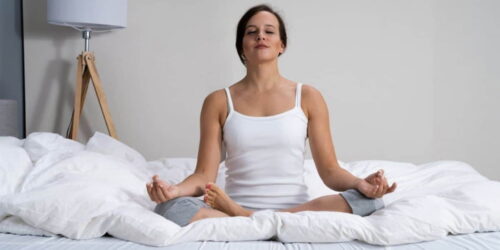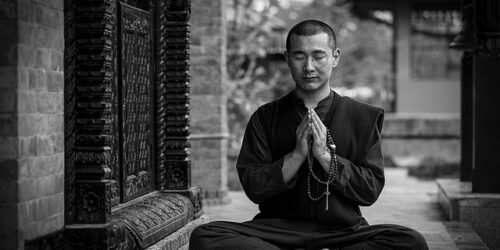What Is Walking Meditation? All You Want To Know
Where was your mind the last time you went for a solo walk—in the city, your neighborhood, a nearby park, or a far-off hiking trail? Have you made a call? What were you listening to—music or a podcast? Or perhaps your mind was elsewhere. Our legs naturally move while we are distracted when we are outside; it’s almost natural.
Walking meditation is a mindfulness practice that blends the physical experience of walking with the focused mindfulness of a meditative state. Walking meditation mobilizes meditation by allowing you to concentrate on the connection between your mind and body as you move quickly around a room or outside.
You control your session length and walking speed with this type of meditation. A walking meditation session involves the practitioner taking a few steps for a predetermined amount of time while concentrating on the body’s motions and feelings.
Please read on.
Table of Contents
What Is A Walking Meditation?
You typically walk in a circle, back and forth in a straight line, or in a labyrinth when practicing walking meditation. You can walk for longer distances while meditating as well.
Depending on the particular technique, the pace is slow and can change. In between seated meditations, practitioners frequently engage in walking meditation.
Examples of walking meditations include:
- kinhin
- theravada
- vipassana
Techniques can range from being as intricate as breaking each step down into six parts to just taking a mindful walk. Use your breath or a mantra as part of the exercise.
The numerous advantages of meditative walking are listed below.
Boost Blood Flow
For those who sit for extended periods, walking meditation is a popular practice. The practice of walking encourages blood flow, particularly in the legs. Feelings of heaviness or stagnancy are lessened.
If you’re doing prolonged seated work, mindful walking is a great way to improve blood circulation and increase your energy.
Improve Digestion
It’s especially beneficial to walk after eating if you feel heavy or full to aid in digestion.
Constipation may be avoided and digestion is aided by movement.
Reduce Anxiety
You might find it helpful to practice seated meditation before or after working out if you’re trying to reduce your stress levels.
Anxiety symptoms can be reduced more effectively by walking when combined with meditation, according to a 2017 study on young adults.
The participants who experienced the greatest reductions in anxiety levels either meditated, meditated before walking, or walked before meditating. People who only walked and the control group did not exhibit as significant improvements. Each walking or meditation session lasted 10 minutes.
Improves Blood Sugar Levels And Circulation
In 2016, a small study found that type 2 diabetics’ blood sugar levels and circulation improved as a result of a walking meditation practice based on Buddhism.
For 12 weeks, participants walked three times a week for 30 minutes either mindfully or normally. Compared to the traditional walking group, the Buddhist walking practice group displayed more improvement.
Alleviates Depression
Maintaining your fitness is crucial, particularly as you get older. Regular exercise helps to increase fitness levels and boost mood, both of which are susceptible to deterioration in older adults.
In a small 2014 study, older people who practiced Buddhist walking meditations three times a week for a period of 12 weeks showed a reduction in depressive symptoms. Additionally, they experienced improvements in their functional fitness levels and blood pressure.
Improves Well-being
When you can, go for a walk in a natural setting, such as a park, garden, or area with trees. This can improve your mood and help you feel more balanced.
The benefits of forest bathing, such as relaxation and increased brain activity, make it a common practice in Japan.
A 2018 study found that people’s blood pressure, anxiety, and mood all improved after a 15-minute walk through a bamboo forest.
Improves Sleep Quality
Exercise does not always require a rigorous workout in order to reap its benefits. 2019 studies revealed that regular, moderate exercise improves the quality of sleep.
Walking can help you feel better physically by reducing stress and increasing flexibility.
Additionally, if you walk in the morning in particular, you’ll be more likely to feel less stressed and anxious. Your mind will be calm and clear after receiving all of these advantages, enabling you to fall asleep easily and sleep soundly each night.
Makes Exercise Enjoyable
Your fitness routine may be more enjoyable if you add a mindfulness component to it.
Researchers in a small 2018 studyTrusted Source found that people who listened to a mindfulness recording while doing a 10-minute walk on a treadmill found the activity more enjoyable. They were instructed to take an objective look at their physical sensations.
This suggests that practicing mindfulness might encourage forging new connections with exercise.
Inspires Creativity
Developing mindfulness may help you think more clearly and precisely, which can foster creativity.
There is a connection between mindfulness and creativity, according to 2015 research. There is a need for more research on the specifics of creativity and mindfulness.
You can investigate how improving your problem-solving abilities or the development of fresh ideas can be accomplished while doing this.
Enhances Balance
Walking meditation may promote better balance as well as ankle awareness and coordination, according to a 2019 study on older women.
Walking slowly while paying attention to your ankle and leg movements is part of the practice. See more about Can You Meditate Lying Down?
How To Meditate While Walking?
Anywhere you have enough room to comfortably take a few steps, whether inside your home or outside in a park, you can engage in walking meditation.
Pick A Place
In a place where you feel safe and have enough space to move around comfortably, practice mindful walking. While the environment need not be completely silent, it should be free from most distractions.
Start Walking
Take 10 to 20 steps in a row, going more slowly than usual. Put one foot in front of the other slowly and rhythmically, and take deliberate steps. After finishing those steps, turn around and proceed back the same way, moving slowly.
Pay Attention
Take note of how your legs feel as you lift them into the air and as they touch the ground. Note any additional feelings you have while walking. Your thoughts may start to stray as you walk. To refocus your attention, use the sensations and sounds of your breathing and steps. Simply acknowledge any sounds you can’t block out from the distance before turning your focus back to your breathing and steps. Spend at least 10 to 15 minutes every day doing this.
Practice
Meditation while walking requires persistence and practice. To get the most out of walking meditation, try to incorporate it as much as you can into your daily life.

Notice How The Soles Of Your Feet Feel
the sensations they experience as you walk, the contact they have with your socks or shoes, the textures of the fabrics that touch them. Feel the entire foot, paying attention to how it moves as the heel is pressed firmly into the ground before the movement rolls to the ball and toes. Take note of how it feels as the foot lifts and advances. As you walk, let your awareness ascend through every area of your body, observing the sensations. Focus on the ankles, skins, calves, knees, thighs, hips, pelvis, back, chest, shoulders, arms, neck, and head before gradually scanning the rest of your body.
Let go of any tension you feel in any part of your body. Give your body’s affected area a chance to unwind. Relax your entire body, including your arms, shoulders, neck, belly, and ankles. Let your hips swing freely. The walking will become more enjoyable as you do this.
You can either systematically scan your entire body from the bottom of your feet to the top of your head while paying attention to walking sensations, or you can scan your body haphazardly by shifting your awareness from place to place in your body. The most crucial thing is to keep your awareness focused on your body’s sensations and to quickly bring it back when your mind wanders.
Walking Meditations Types And Getting Outside
Looking for more mindfulness exercises in the great outdoors? The Headspace app offers members several courses and single meditations on exercises in and appreciation of the outdoors, including:
- meditation on the love of the Earth. We can develop our ability to love, respect, and care for all living things when we begin to recognize the benefits that the Earth provides for us.
- Engage in a mindful activity to connect with the world. Think about everything you see and hear, and pay attention to how your body moves around.
- Mindful exercise: nature walk. By using this exercise and technique, you can disconnect from your thinking mind and re-connect with nature.
- The mindful activity of city walking. You can calm your mind and feel more at one with your body and the environment by focusing on your awareness.
- Run with awareness. Join Headspace’s Andy Puddicombe and Nike Running Global Head Coach Chris Bennett for an introductory run.
- Run Smart with awareness. Become more conscious of your thoughts as you run to try and alter your running style.
- Continue your mindfulness-based running. When you require additional guidance from Andy and Nike Coach Chris Bennett to maximize a workout, use this run.
- Mindful activity in the garden. Use an exercise to stimulate your senses and motivate you to go outside and smell the roses.
Walking In The City
In the hustle and bustle of any city, distractions abound from the pace of life as well as from sights, sounds, and smells. But that doesn’t mean we can’t be mindful of our surroundings and be in the moment. In a city, there is probably more mental stimulation, making it even more important to keep your thoughts anchored to your walking rhythm.
Take note of your gait: Are you scurrying along with a hundred thoughts racing through your head? Or do you saunter around while daydreaming? You step more deeply into your body as you become more aware of your gait, any sensations, and how you move. More body awareness translates into greater awareness of your surroundings.
Walking In Nature
Perhaps there isn’t anything more rejuvenating than going outside and taking a walk in the outdoors, taking in all the sights, sounds, and scents. A routine walk can be transformed into an intimate experience and appreciation of life by checking in with both yourself and the surroundings. The only real distractions in a natural setting, such as a park, river, forest, or mountain trail, will be your own thoughts (or any devices you may have brought with you).
Maintain a steady, comfortable rhythm, walk naturally, and pay attention to your posture and any physical sensations you may be experiencing. As a point of gentle focus, use the walking rhythm of left foot, right foot, left foot, right foot. By doing this, you are allowing the mind to enter a state of relaxation so that it can fully interact with the surroundings and the present moment.
Walking In Your Home
Due to illness or bad weather, going for a long walk isn’t always possible. You can still meditate while walking inside despite this, though. It just requires making good use of the interior space. As long as there is enough room to take 10 to 20 steps in a straight line without hitting anything, you can walk the entire length of a room or hallway.
Simply walk back and forth between the marked start and end points, taking slow, deliberate steps while observing how the body feels, noticing the movement, and bringing your attention to the rhythm of the walk each time the mind wanders.
Conclusion
Where was your mind when you were last out on a solo walk—whether it was through the city, your neighborhood, a nearby park, or a wilderness hiking trail? A phone call was made by you. Did you have any music or a podcast playing? Or perhaps you were preoccupied with your thoughts. Our legs naturally move while our attention is diverted when we’re outside; it’s almost instinctive.
A walking meditation is intended to synchronize the body and mind while we are moving about. This is a great alternative to traditional meditation if you prefer not to sit still and close your eyes while doing it. It still sharpens mental awareness.
We appreciate you reading.





